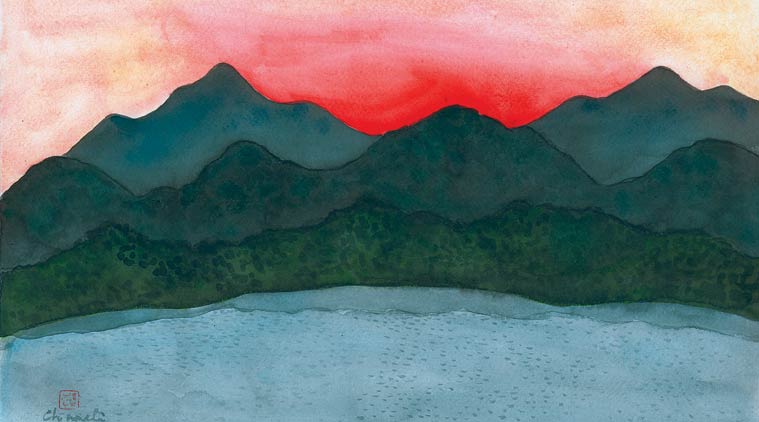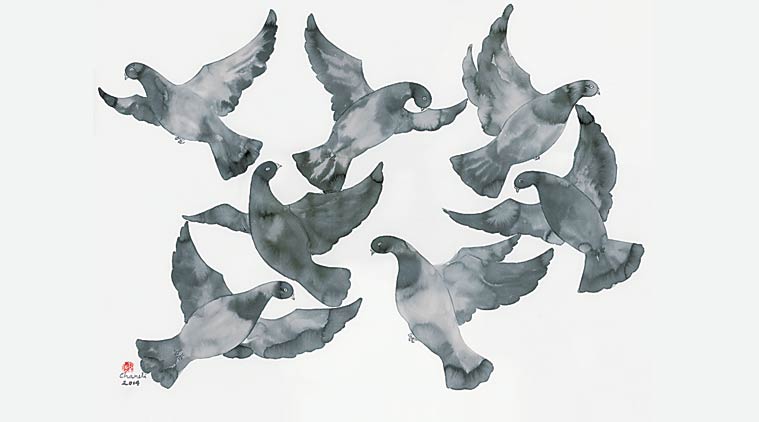And the Flowers Bloomed
Artist Chameli Ramachandran brings out the simplicity of a rather complex world in her calligraphic works.
 Chameli Ramachandran (above); her work on display at Vadehra Art Gallery in Delhi (Source: Express Photo by Praveen Khanna)
Chameli Ramachandran (above); her work on display at Vadehra Art Gallery in Delhi (Source: Express Photo by Praveen Khanna)Named Chameli after the fragrant jasmine flower by Nobel Laureate Rabindranath Tagore, she has carried it as a signifier of the mingling of Indian and Chinese cultures. After all, the two identities have shaped her life, and also her art, which has always been defined by poetic brushwork, a blend of ink and metallic colours that paint the turbulent waves, coconut palms and lotus flowers floating calmly in a pond.“My art is an immediate outcome of what I see and find impactful,” says the artist in a conversation at her Bharti Nagar home in Delhi. Across the city, Vadehra Art Gallery is holding her sixth solo. The reticent 75-year-old artist started showing her work a little more than two decades ago only. “I was working, but in private. Also, I was taking care of my family,” she says.
Wife of the more vocal and visible artist, A Ramachandran, Chameli preferred to stay away from the limelight, in a world of art that she had built for her self.
[related-post]
Born to professor Tan Yun Shan, founder-director of Cheena Bhavana (Institute of Chinese Studies) at Visva Bharati University, Chameli and her six siblings grew up in the greens of Santiniketan, studying Bengali and humming Rabindrasangeet. She referred to the same Rajasthani miniatures, Kalighat paintings and Ajanta murals that influenced Nandalal Bose and Ramkinkar Baij, and even approached the latter with her own works in her teens. “I used to go to Baij to show him my work. Of course he was too senior and I was too young but he was encouraging nevertheless,” she says.
Marriage brought her to Delhi, but the childhood influences were ingrained too deeply to be forgotten. So when Chameli picked the brush, she instinctively turned to calligraphic patterns. She laboriously ground ink tablets to prepare them for painting, supplementing them with bottled ink. “The texture, if you do it on your own, is so much richer,” she says. The patterns came from close surroundings. If in the beginning she painted garden-varieties such as hibiscus, gardenia and the peepal outside her Delhi home, frequent trips to her husband’s native Thiruvananthapuram inspired her to capture the coconut palms and lotuses that abound there, and the rocky outcrops on the beaches. The cluster of coniferous trees and snow-capped mountains near her son’s North America home, too, make an appearance.
While free brush strokes remain her trademark, subtle changes have taken place over the years. The lotus flower, for instance, has blossomed and now has a touch of metallic sheen added to the undersides of the lotus-pad. “It’s a fascinating flower, ethereally beautiful and with a significance in several eastern countries,” says Chameli, who, along with her husband, has also illustrated several books for children based on tales they narrated to their kids. “Our books were born from stories we told them. The stories that kept them interested and opened a new world of innocence for us,” says Chameli.
At home, too, she is the introvert who lets her husband be their public face, and is happy to let her work do the talking.











































